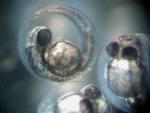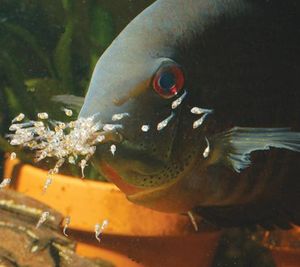Fish/How fish breed
A host of subtle adaptations distinguish the breeding methods of different fish families, although there are two general breeding categories. Most fishes (the "egg-layers") lay and fertilize their eggs externally; the eggs of others (the "livebearers") are fertilized and developed inside the female body. The ways in which eggs are fertilized, and young are protected and provided for, differ dramatically in the aquatic world, where predation and cannibalism are rife.
Livebearers
The anal fin of a male livebearer is often modified to form a reproductive organ called the gonopodium. It is used to inject sperm into the female fish. Gestation takes about a month at average tropical aquarium temperatures, after which the young fry are ejected into the water, ready to fend for themselves. Females of the more popular cultivated livebearers, like guppies and swordtails, are able to store sperm internally and can produce successive broods of fry without remating. These are known as ovoviviparous breeders. For species that cannot store sperm internally (viviparous breeders), mating is necessary for each brood. All developing fry receive nourishment through a type of placenta.
Egg Scattering
This is the simplest form of egg-laying (or oviparous) reproduction. The eggs (ova) are ejected by the female into the water, usually after a hectic pursuit by the male, which stimulates egg release. They are fertilized by the male's liquid sperm, but only the eggs that float away on currents or fall among plants or pebbles survive; the rest are soon eaten by other fish and even the parents. Many eggs are laid to increase the chances of survival.
Egg burying
The waters in which egg-buryers live dry up completely once a year. Species survival relise on the fertilized eggs withstanding dehydration, often for months, and then hatching once they are reimmersed in water during the rainy season. In captivity, the eggs from these fish must be collected and stored, nearly dry, for a period of time before rehydration.
Egg-depositing
Egg-depositing fishes protect their eggs to some degree after they are laid. The fish deposit eggs carefully on the underside of leaves, inside rocky caves, or on the leaves of overhanging plants above the waters surface. Some species use flat surfaces far out in the open water, or even a special pouch carried by the male. Egg guarding and fry-herding are also practiced by this group. Fish that exhibit parental care will often pair off naturally.
Mouth-brooding
Mouth-brooding females store fertilized effs in their throats until they hatch weeks later. They may abstain from feeding until the fry are free-swimming and, at any hint of danger, the fry seek refuge back in their mothers mouth. Mouth-brooders have no special breeding requirements apart from a separate tank. Male mouth-brooders of the Rift Valley cichlids have egg spots on their anal fins. The female nudges these and so stimulates the release of sperm.
Nest-building
Tropical fishes build a variety of nests: some dig pits in the sand, while others build bubble nests. Males make a nest of saliva coated bubbles to coax the female beneath them, where eggs are aid, fertilized, and then placed in the nest. Depending on the species, bubble nests may be floating masses or collections of bubbles underneath plant leaves.


